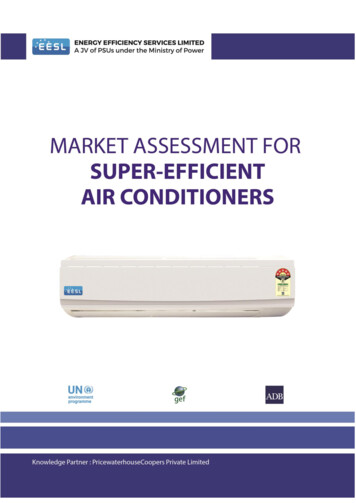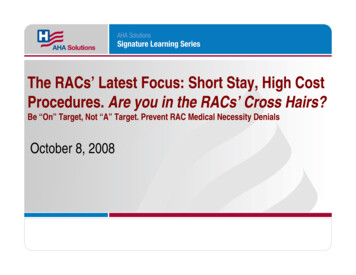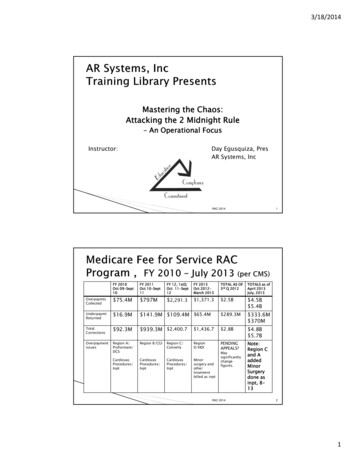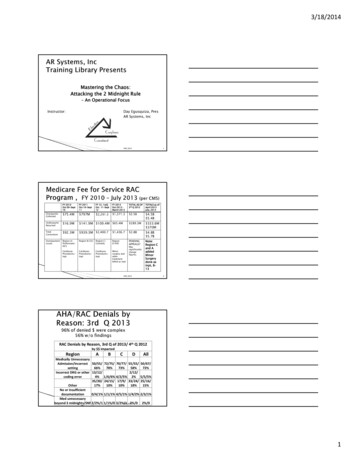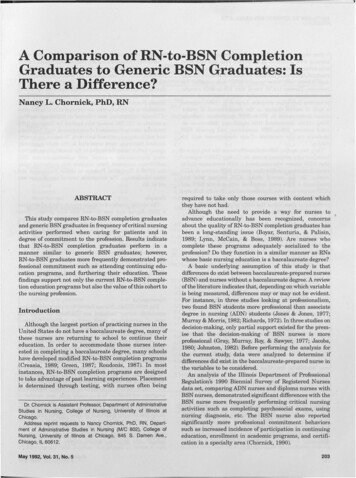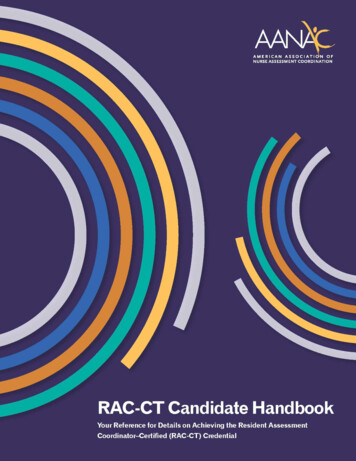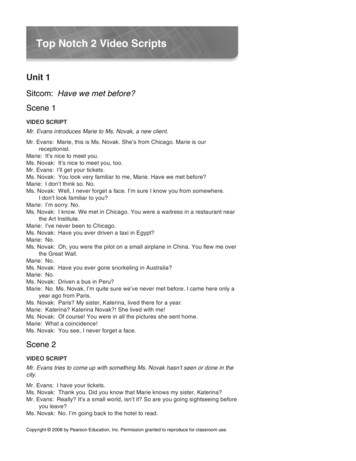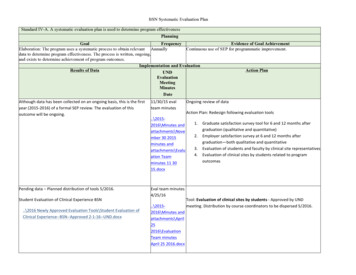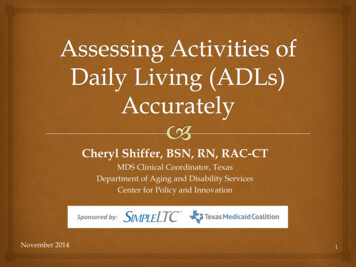
Transcription
Cheryl Shiffer, BSN, RN, RAC-CTMDS Clinical Coordinator, TexasDepartment of Aging and Disability ServicesCenter for Policy and InnovationSponsored by:November 20141
Objectives Discuss the process to evaluate each aspect of anActivity of Daily Living (ADL). Define who is and who is not included in thedefinition of facility staff used in Section G of theMDS. List the current MDS 3.0 ADL self-performancedefinitions.2
Objectives Analyze the “Rule of Three” used for ADL selfperformance coding on the MDS. Apply the “Rule of Three” to real-world examples ofADL coding submitted by provider staff. Discuss CMS Memorandum 15-06-NH announcingthe nationwide expansion of MDS focused surveys in2015.3
Aspects of ADLs Defined on Page G-2 of the MDS 3.0 RAI Manual(RAIM3): “ADL ASPECTS Components of an ADL activity. These are listednext to the activity in the item set. For example, thecomponents of G0110H (Eating) are eating, drinking,and intake of nourishment or hydration by othermeans, including tube feeding, total parenteralnutrition and IV fluids for hydration.”4
ADL Aspects ADL Aspects (i.e., ADL Components) are also listedon Page G-3 to G-4 of the RAIM3. Each item listed as an aspect of an ADL is evaluatedseparately. The most dependent level of self-performance forany component (aspect) of an ADL is the code directcare staff enters for that episode of care.5
Coding ADL Aspects The most dependent self-performance level for any aspectof an ADL care is the correct self-performance coding forthat particular occurrence or episode of the ADL beingevaluated, except Total. When every aspect of the ADLself-performance is not Total, but one or more aspects areTotal, the correct coding is extensive. Bed Mobility - how resident moves to and from lyingposition, turns side or side, and positions body while inbed or alternate sleep furniture (page G-4, RAIM3).6
Coding ADL Aspects Scenario A: A resident sits on the bed and lays downindependently but needs extensive assistance to situp, limited assistance to turn side to side andextensive assistance to reposition their body. On the night shift from 11p-7a, one staff turned theresident 3 times, one staff helped the resident sit upin bed once at a different time and one staff helpedthe resident reposition once at yet a different time.7
Coding ADL Aspects Identify the correct ADL coding for each episode(occurrence) of Bed Mobility that was provided onthe night shift. Hint: There will be 5 answers!8
Coding ADL Aspects Transfer - how resident moves between surfacesincluding to or from: bed, chair, wheelchair, standingposition (excludes to/from bath/toilet) (page G-4,RAIM3). Scenario B: A resident needs extensive assistance tomove to or from the bed to or from the wheelchairand also needs extensive assistance to stand whenmoving to or from the bed or the wheelchair.9
Coding ADL Aspects On the evening shift from 3p-11a, one staff helpedthe resident transfer from the bed to the wheelchairto eat dinner. One staff helped the resident transferfrom the wheelchair back to bed after dinner andlater helped the resident from the bed to thewheelchair to visit friends. One staff helped theresident transfer from the bed to the shower chairand one staff helped the resident transfer from theshower chair to the wheelchair. One staff helped theresident transfer from the wheelchair back to bed.10
Coding ADL Aspects Identify the correct ADL coding for each episode(occurrence) of Transfer that was provided on theevening shift. Hint: There will be 4 answers!11
Coding ADL Aspects From page G-4 of the RAIM3, “If a resident usesspecial adaptive devices such as: A walker, device to assist with donning socks,dressing stick, long-handled reacher, or adaptiveeating utensils, Code ADL Self-Performance and ADL SupportProvided based on the level of assistance the residentrequires when using such items.”12
Facility Staff Defined on Page G-5 of the MDS 3.0 RAI Manual(RAIM3): FACILITY STAFF are “direct employees and facilitycontracted employees (e.g. rehabilitation staff,nursing agency staff). Thus, does not includeindividuals hired, compensated or not, byindividuals outside of the facility's management andadministration. Therefore, facility staff does notinclude, for example, hospice staff, nursing/CNAstudents, etc. “13
Facility Staff Includes Nurses Agency Nurses Graduate Nurses hired by the facility and workingunder the supervision of facility staff Certified Nursing Assistants (CNAs) Agency CNAs14
Facility Staff Includes Nurse Aides within 4 months of facility employmentwhile enrolled in CNA training, but only whenworking in the facility and not when actuallyparticipating in CNA training or testing on thepremises. In-house Therapy Staff Contracted Therapy Staff15
Facility Staff Does NOT Include Hospice Nurses Hospice CNAs Nurse Aides participating in CNA training or testingon the premises Nurse Students participating in Nurse training ortesting on the premises16
Facility Staff Does NOT Include Ambulance/Transport Staff Radiology/X-Ray Staff Laboratory Staff17
G0110, Column 1, ADL Self-Performance 1. From page G-5 of the RAIM3:2. Item G0110 involves a two-part ADL evaluation:3. Self-Performance, which measures how much of the ADLactivity the resident can do for himself or herself, and SupportProvided, which measures how much facility staff support isneeded for the resident to complete the ADL.4. Each of these sections uses its own scale, therefore, it isrecommended that the ADL Self-Performance evaluation(Column 1) be completed for all ADL activities beforebeginning the ADL Support evaluation (Column 2).18
Coding Instructions for G0110, Column 1 Code 0, independent: if resident completed activity withno help or oversight every time during the 7-day lookback period and the activity occurred at least three times. Code 1, supervision: if oversight, encouragement, orcueing was provided three or more times during the last7 days. Code 2, limited assistance: if resident was highlyinvolved in activity and received physical help in guidedmaneuvering of limb(s) or other non-weight-bearingassistance on three or more times during the last 7 days.19
Coding Instructions for G0110, Column 1 Code 3, extensive assistance: if resident performed part of theactivity over the last 7 days and help of the following type(s)was provided three or more times:— Weight-bearing support provided three or more times, OR— Full staff performance of activity three or more times duringpart but not all of the last 7 days. Code 4, total dependence: if there was full staff performanceof an activity with no participation by resident for any aspectof the ADL activity and the activity occurred three or moretimes. The resident must be unwilling or unable to performany part of the activity over the entire 7-day look-back period.20
Coding Instructions for G0110, Column 1 Code 7, activity occurred only once or twice: if theactivity occurred fewer than three times. Code 8, activity did not occur: if the activity did notoccur or family and/or non-facility staff providedcare 100% of the time for that activity over the entire7-day look-back period.21
Item G0110 Steps for Assessment 1.Review the documentation in the medical record for the 7-daylook-back period.2.Talk with direct care staff from each shift that has cared for theresident to learn what the resident does for himself duringeach episode of each ADL activity definition as well as thetype and level of staff assistance provided. Remind staff thatthe focus is on the 7-day look-back period only.3.When reviewing records, interviewing staff, and observing theresident, be specific in evaluating each component as listed inthe ADL activity definition.(Page G-3, RAIM3)22
Item G0110 The Rule of 3 The “Rule of 3” is a method that was developed to helpdetermine the appropriate code to document ADL SelfPerformance on the MDS. It is very important that staff who complete this sectionfully understand the components of each ADL, theADL Self-Performance coding level definitions, and theRule of 3.(Page G-6, RAIM3)23
Item G0110 The Rule of 3 To properly apply the Rule of 3, the facility must first note: Which ADL activities occurred, How many times each ADL activity occurred, What type and What level of support was requiredFor each ADL activity over the entire 7-day look-backperiod.(Page G-6, RAIM3)24
Exceptions to The Rule of 3: From page G-6 of the RAIM3: Code 0, Independent – Coded only if the residentcompleted the ADL activity with no help oroversight every time the ADL activity occurredduring the 7-day look-back period and the activityoccurred at least three times. Code 4, Total dependence – Coded only if theresident required full staff performance of the ADLactivity every time the ADL activity occurred duringthe 7-day look-back period and the activity occurredthree or more times.25
Exceptions to The Rule of 3: Code 7, Activity occurred only once or twice –Coded if the ADL activity occurred fewer than threetimes in the 7-day look back period. Code 8, Activity did not occur – Coded only if theADL activity did not occur or family and/or nonfacility staff provided care 100% of the time for thatactivity over the entire 7-day look-back period.26
Instructions for the Rule of 3: From page G-7 of the RAIM3: These steps must be used in sequence. Use the first instruction encountered that meets thecoding scenario (e.g., if #1 applies, stop and codethat level).27
Instructions for the Rule of 3: From page G-7 of the RAIM3:1. When an activity occurs three or more times at anyone level, code that level.Scenario C: In the 7-day look-back period, Bed Mobilityself-performance ADL coding was 4, 4, 3, 2, 2, 2, 2.How would G0110A be coded on the MDS?28
Instructions for the Rule of 3: From page G-7 of the RAIM3:2. When an activity occurs three or more times atmultiple levels, code the most dependent level thatoccurred three or more times.Scenario D: In the 7-day look-back period, Transfer selfperformance ADL coding was 4, 4, 4, 3, 2, 2, 2.How would G0110B be coded on the MDS?29
Instructions for the Rule of 3: From page G-7 of the RAIM3:3. When an activity occurs three or more times and atmultiple levels, but not three times at any one level,apply the following:a. Not a true step – general instructions.b. When there is a combination of full staff performanceand weight-bearing assistance that total three or moretimes—code extensive assistance (3).30
Instructions for the Rule of 3: c. When there is a combination of full staffperformance/weight-bearing assistance, and/ornon-weight-bearing assistance that total three ormore times—code limited assistance (2).If none of the steps listed (1 through 3) are met, codesupervision.31
Instructions for the Rule of 3: Scenario E: A resident was admitted to the facility for twodays prior to discharge. During this time, Transfer selfperformance was 4, 3, 3, 2, 2.How would self-performance for G0110B be coded on thedischarge MDS?32
G0110, Column 2, ADL Support Coding Instructions from page G-9 of the RAIM3: Code for the most support provided over all shifts. Code regardless of how Column 1 ADL SelfPerformance is coded.33
G0110, Column 2, ADL Support Code 0, no setup or physical help from staff: if resident completedactivity with no help or oversight. Code 1, setup help only: if resident is provided with materials ordevices necessary to perform the ADL independently. This caninclude giving or holding out an item that the resident takes from thecaregiver. Code 2, one person physical assist: if the resident was assisted by onestaff person. Code 3, two person physical assist: if the resident was assisted bytwo or more staff persons. Code 8, ADL activity itself did not occur during the entire period: ifthe activity did not occur or family and/or non-facility staff providedcare 100% of the time for that activity over the entire 7-day period . 34
Applying the “Rule of 3” Review each of the following examples to determine thecorrect ADL self-performance code and ADL supportcode for the appropriate Item G0110 on the MDS.35
G0110A Bed Mobility NN: 10/2/14 @ 2020 - Res. in bed resting quietly. ExtensiveAssistance x 2 for positioning.Scenario F Bed Mobility Coding: Self-Performance? Support?36
G0110A Bed Mobility Scenario G Bed Mobility Coding: Self-Performance? Support?37
G0110B Transfer Scenario H Transfer Coding: Self-Performance? Support?38
G0110H Eating xScenario I Eating Coding: Self-Performance? Support?39
G0110I Toileting NN: 3/10/14 @ 1500 – Res assisted to toilet. Required CNAx1 to pull up pants and adjust clothing. -----------J. Doe, LVNScenario J Toileting Coding: Self-Performance? Support?40
CMS S&C Memorandum15-06-NH DATE: October 31, 2014SUBJECT: Nationwide Expansion of Minimum Data Set(MDS) Focused Survey41
CMS S&C Memorandum15-06-NH MDS / Staffing Focused Surveys: In mid-2014, the Centersfor Medicare & Medicaid Services (CMS) piloted a shortterm focused survey to assess Minimum Data Set, Version3.0 (MDS 3.0) coding practices and its relationship toresident care in nursing homes in five states. CMS willexpand these surveys in 2015 to be conducted nationwide.Reported Staffing: The scope of some or all of the focusedsurveys will also be expanded to include an assessment ofthe staffing levels of nursing facilities. This assessment willaim to verify the data self-reported by the nursing home, andidentify changes in staffing levels throughout the year.42
CMS S&C Memorandum15-06-NH 24 out of 25 MDS Focused Surveys conducted in 2014identified deficient practices in the following areas: Inaccurate staging and documentation of pressureulcers, Lack of knowledge regarding the classification ofantipsychotic drugs, and Improper coding regarding the use of restraints.43
CMS S&C Memorandum15-06-NH In FY2015, MDS/Staffing Focused Surveys will be conductednationwide. MDS 3.0 inaccuracies and lack of sufficient staffing notedduring the survey will result in relevant citations. Deficiencies could include those related to quality of careand/or life, or nursing services. If patterns of inaccuracies are noted, the case will be referred tothe CMS Regional and/or Central Office for follow-up. If care concerns are identified , the concerns may be cited orreferred to the State Agency as a complaint for further review.44
Thank You! The Scenario Answer Key will be posted separately. Texas provider staff with ADL coding questions shouldcontact Cheryl Shiffer, BSN, RN at 210-619-8010 orcheryl.shiffer@dads.state.tx.us. Always include yourTexas facility SNF/NF or Swing Bed name whencalling or writing. Outside of Texas, please contact your State RAICoordinator. A list is located in Appendix B, RAIM3.45
of an ADL care is the correct self-performance coding for that particular occurrence or episode of the ADL being evaluated, except Total. When every aspect of the ADL self-performance is not Total, but one or more aspects are Total, the correct coding is extensive. Bed Mobility - how resident moves to and from lying
